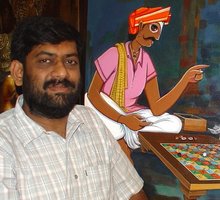The Order of Gandaberunda
 |
| Fig.0. HH Sri Sir Chamarajendra Wadiyar Bahadur. Artist: K. Keshavayya. Collection: Mythic Society, Bengaluru |
The reason for recalling this princely honour is that 2017 marks 125 years of the institution of Order of Gandaberunda (Figure 1).
 |
| Fig.1. Order of the Gandaberunda |
During Krishnaraja Wadiyar the IV’s rule these Orders and titles were conferred from the throne on the European Durbar Day during the Dasara festivities but from 1942 Maharaja H.H. Jayachamraja Wadiyar conferred awards on his birthday festivities till 1949.
 |
| Fig.2. Dewan Sheshadri Iyer. Artist: Felix Wicksler. Collection: Banquet Hall, Vidhana Soudha, Bengaluru |
Earlier when H.H. Nalwadi Krishnaraja Wadiyar wanted to continue giving of the Gandaberunda Order, the Resident wanted to know why there was any necessity at all. H.H. Maharaja Nalwadi Krishnaraja Wadiyar’s caustic riposte: “They are merely the continuance of the ancient custom of conferring Birudus and Mana Mariyadas (titles, decoration, souvenirs, Khillats etc) on persons who by their learning, benevolence or services to the public, the State or the Sovereign, have deserved recognition at his hands.” (Dewan of Mysore’s letter to the Resident, September 7th 1920/ Residency records of Mysore/India Office /IOLRR2/ (37/354).
 |
| Fig.3. Double-headed Eagle Stupa, Sirkap, Taxashila |
 |
| Fig.4. Vishnu Nidhi of Sritattva Nidhi |
 |
| Fig.5. Berundeshwara, Balligave |
 |
| Fig.6. Ceiling relief, Rameshwara temple, Keladi, Shimogga District, Karnataka |
The unique form of the Gandaberunda led to kingdoms like Chalukyan, Hoysalas, Keladi Nayak, and the Kadambas and of course the Wadiyars using the motif in crests and seals. The Vijayanagar king Achyuta Deva Raya (1529–1542) was perhaps the first to use the Gandaberunda image on gold pagodas (gadyana) (Figure 7).
 |
| Fig.7. Obverse and reverse of Gadyana |
 |
| Fig.8. Sphinx Gate, Hittite temple, Alaca Hoyuk, Turkey |
The Padaka consisted of the Royal emblem, the twin-headed bird with wings displayed, all within a wreath open at the top. From the points of which were attached the chain to pass around the neck. The body and wings of the bird and the leaves of the wreath were composed of Rubies, Emeralds, Sapphires interspersed with diamonds depending on the class. There was also another variation in design wherein the Gandaberunda was encased in a gem-studded collet. The Order was suspended around the neck by a golden chain with button shaped flower encrusted with precious stones according to the class awarded.
 |
| Fig.9. Original illustration of Class B Pendant. Collection: Ramsons Kala Pratisthana |
By 1944 the Gandaberunda Order was reclassified: A1 reserved for Dewans and chief ministers, A2 for the chief justice, B1 (Figure 9) for ministers and judges of high courts and important Sirdars, B2 for heads of departments, C1 for significant donations to charities, C2 for proficiency in fine arts, and D (Figure 10) for scholars and musicians.
 |
| Fig.10. Original illustration of Class D Bracelet. Collection: Ramsons Kala Pratisthana |
 |
| Fig.11. Collection: M.R. Rajaram, Mysuru |
A variation of the Gandaberunda Order for military service seems to have stemmed from the fact that in the Great War (1914-1919) Mysore State had attached regiments of the Imperial Service Lancers (Mysore Lancers) and the Mysore Transport Corps and it was felt that a war medal be instituted to honor men who had shown exceptional bravery. These were in four classes: First Class, Second Class, Third Class and Fourth Class and promulgated in the Mysore Durbar Orders. (From letters of Lt. Col R. E. Holland, C.I.E., Political Secretary to the Govt of India., to H.V. Cobb, Resident at Mysore, December 1919 –Residency Records/Mysore/ IOLRR/2//36/350/Mysore War Medal)
Two of the awardees of the Order of the Gandaberunda First Class for bravery in the Great War were Col. Desaraj Urs and B. Chamaraja Urs. Col. Desaraj Urs was the brother-in-law of the Maharaja H.H. Krishnaraja Wadiyar IV while Sirdar Bahadur B Chamaraja Urs was the grandfather of Maharani H.H. Tripurasundaramanni Avaru!
 |
| Fig.12. Col. Desaraj Urs. Photo Courtesy: R. Raja Chandra |
Sirdar Bahadur Chamaraja Urs saw action in Gaza (Palestine) in November 1917. On the 7th February 1918 Brigadier- General C.R. Harbard, Commanding the Imperial Service Cavalry Brigade ‘mentioned in despatches‘ the bravery of Risaldar B Chamaraja Urs of Mysore Lancers with the recommendation that the Maharaja of Mysore be informed forthwith. The Maharaja honored Chamaraja Urs with the first class Medal of the Gandabherunda Order and the position of Lt. Col. in the Mysore State Forces.
Incidentally the insignia of the Gandaberunda was incorporated in the design of golden cuff-links gifted to Europeans on the Durbar Day during the reign of H.H. Krishnaraja Wadiyar IV (Figure 13)
 |
| Fig.13. Golden Cufflink of Gandaberunda |
One more interesting tidbit is that among the scores of Gandaberunda insignias found in stained glass, iron fretwork, Stone, stucco and even cement seen at the Chamarajendra Technical Institute (CTI), the Lalitha Mahal Palace Hotel, K.R. Hospital, Fire Brigade, several ones in the Palace, the Police Commissioner’s office and other places are not identical. Each seems to have its own unique variation.
To those interested in the memorabilia of Indian princely medals, this writer recommends two eminently readable books: “Indian Princely Medals” by Tony McClenaghan and Wing Commander E.H. O’Toole’s “Decorations of the Indian Princely States.”

